Identity Document Verification: AI-backed System to Counter Identity Fraud
Nowadays, companies face different obstacles in their development. On one hand, the technological revolution has supported various industries but has also empowered fraudsters to use sophisticated scamming techniques. In this context, companies want an advanced digital solution that can protect them from identity theft, money laundering, and terrorism financing cases. Identity document verification is an ideal solution to resolve the above challenges efficiently. As per statistics, the global IDV market had a financial worth of $8.43 billion in the year 2021. By 2030, it will reach around $33 billion. It guarantees fast and accurate verification results. Hence, it ensures compliance with KYC/AML guidelines and protects clients from heavy financial penalties.
Identity Document Verification: Dealing with Identity Theft Cases with Latest Approach
Undoubtedly, identity theft is a heinous crime. Crime is defined as the act of stealing someone’s identity in order to exploit the benefits linked with them or damage the reputation of the victim to inflict psychological harm. Cybercriminals can use various techniques to manipulate their target. For example, after stealing their identity, hackers can take over their bank accounts for financial benefits or use social media channels to bully them.
How has the Legal Department in the USA Resolved the Identity Theft Cases?
The following legal interventions are critical in deterring identity theft cases. However, such issues require consistent effort to beat cybercriminals in their own game.
- According to the Identity Theft and Assumption Deterrence Act of 1998 (ITADA), identity theft is an unlawful activity that has serious criminal penalties for the offenders
- As per the USA Department of Justice, the consequences of identity theft include 15 years in prison and confiscation of all the materials that aided in the crime
In order to combat identity theft and other digital fraud, the identity legal document verification service will play a critical role. The system will highlight any bad actors that try to bypass the security protocols of the businesses.
Identity Document Verification System: Involving the RegTech Industry
Global regulatory bodies such as FATF have enforced AML/KYC laws to counter digital fraud across the globe. According to the regulations, it is the responsibility of all businesses to ensure compliance with guidelines or be ready to face serious repercussions. The AML standards state that it is critical for industries to perform suitable due diligence procedures on the customers to tackle rising fraud cases.
There are two review processes named Customer Due Diligence and Enhanced Due diligence (CDD & EDD). The first one is basic and all the onboarding customers go through it whereas the second one is more detailed and executed on high-risk clients. For instance, it is performed on the profiles of PEPs (Politically Exposed Person).
The KYC procedure is crucial for all companies to deter the fraud attempts of hackers. The technological revolution has made matters easier than before. The application of Artificial intelligence & ML algorithms has enhanced the efficiency and availability of identity document verification services to remote users.
Identity Document Verification System: How Does the ID Record Authentication System Work?
The combination of identity document verification solutions and Artificial Neural Networks (ANNs) allows the users to profit from the service from the website and mobile applications. The procedure of the service is the following.
- The identity document verification software instructs the users to submit their selfie in real-time for comprehensive authentication
- The Optical Character Recognition (OCR) software captures the information from the documents and puts it in the correct categories within the database
- The AI-backed software also checks the authenticity of the documents against certain markers. Such special features are only present in genuine government-issued documents. If the software catches any manipulation, the system rejects the application and notifies the client. Only in the case of genuine records, the customers see the final verification results
Clients must know that the AI-powered system evaluates the documents for special characteristics e.g. unique ink/paper, holograms, and rainbows. The AI-powered system can detect manipulation at micro levels, which the traditional approaches did not.
Conclusion
Finally, the use of an identity document verification system will safeguard the clients from fraud attempts by bad actors. It will only allow data from genuine documents to enter the database of the companies. From the long-term perspective, the implementation of identity document verification service is a pragmatic approach for all industries, especially the banking and healthcare sector. The software is time-saving and resource-effective. The integration of artificial intelligence has made worldwide access to the service easier. It means that end-users can benefit from it without any geographical limitations. Consequently, the system ensures a positive customer experience and adherence to AML/KYC regulations.

